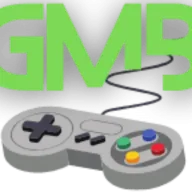Visit is a platformer game by Rotten Tater, aka Ted Lauterbach. Visit is an older game that has since been followed up by Lauterbach’s sequel, Visit 2, which went on to win second place in the YoYo Games “co-operation” themed competition in 2008. Both games were created using GameMaker.
Visit starts out with you taking the roll a cutesy character who is part of an alien race that preserves extra-planetary ruins and artifacts. The goal is simple: maneuver your way through a temple and find the secret to unlocking the main chamber which is held shut by eight keys of different colors. Along the way there are coins of different colors that hold a mysterious purpose that isn’t revealed until the very end of the game.
Now, the kick is, there are little color-altering pads that will imbue you with any of six different colors. These colors allow you to push blocks of a corresponding color. They also remove certain immovable blocks from the field, creating drops and eliminating paths depending on which color you possess at the time. This dynamic is used well in multiple puzzles across the game world that are used to gain access to new areas and obtain keys and coins.
I’ll admit, I’m not a huge fan of platform puzzlers. They usually either try to squeeze in some sort of other combat mechanic, making the puzzles a flow-breaking addition, or the guys who design the puzzles are way, way smarter than me. Visit is definitely the latter. The puzzles are sharp and a bit twisted in some situations where the layout gives you an assumption of a possible solution when really, the answer followed a completely different path to the resolution. I had a few desk-slamming moments when a carefully crafted plan was ruined by a last second oversight. Those disappearing blocks… really, they’re jerks.
The other main gameplay element, somewhat unfortunately, is the jumping. There’s a lot of jumping. And there’s some tricky jumping, and there’s some totally unnecessary jumping. The levels are designed well enough, but expect a lot of airtime trying to get around. The jumping itself tends to be a little sticky, but easy enough to get used to.
The puzzles themselves play nicely. There are a few moments where you’ll think, “uh, seriously?” in certain instances. Some columns of push-blocks will push all at once when you push the bottom block. Others, however, will only push one or two, leaving the rest to topple onto your character’s head unexpectedly. This isn’t including the times where solid terrain blocks are intentionally left to block a tower partially by design. So maybe a little cleanup there during QA would have been nice.
There’s also an unwritten mechanic where push-blocks occupying the same space as a disappeared block will be stuck in that space if the block is re-appeared. This is used as part of the puzzle once or twice, but there’s no ergonomic lead-in to let you learn it as a true mechanic, leaving it feeling to be one of those “it’s not a bug, it’s a feature!” design choices.
My biggest complaint was the backtracking. Puzzles are often used as your sole means to progress, and they reset when you leave a room, which means if you need to come back to explore an unfinished section of map, then you have to solve puzzles all over again. This was irritating on more than one occasion, and especially so as some signs that lead you helpfully in the beginning of the game start pointing over the edges of cliffs, as if left by a malevolent troll saying “Over here! The last yellow coin! Psyche! Have fun going through those three twenty-step puzzles all over again.”
Oh, and the music. It’s ding-y. It’s clang-y. It’s extremely harsh next to the otherwise soft and colorful world it’s presented in. I thought I would give it a shot to see if I would find it endearing over time, but no. There’s a mute button for music only, quite thankfully. The sound effects are cutesy and somewhat pleasant otherwise.
Overall I would recommend this game to any puzzle-lover. It’s good for a spin, and hunting down the complete list of collectibles is worth the effort. If you need a decent distraction to get your brain churning away then Visit will satisfy.
Play Visit on PC.


How is this suitable content? It’s so dated it’s irrelevant.
Heard of classics?
I agree, the backtracking was becoming a pain nearing the end of the game; mostly because I had left a coin behind and completely forgot where it had been. Although I’m almost positive I got all the coins I don’t recall any reward or anything; hmm.
I really enjoyed the puzzles for the most part; assuming they only had to be played once. But I do agree; the sticking block only caused confusion thinking it might be needed in some puzzles when it really wasn’t, etc.
I also stopped the music about 2/3rds of the way through the game.
I finished in 2 hours 39 minutes if anyone needs a time reference.